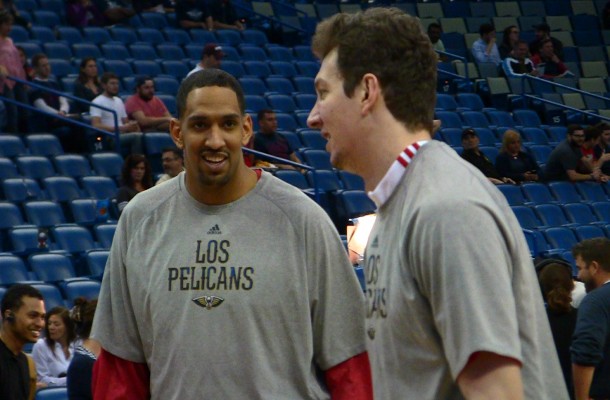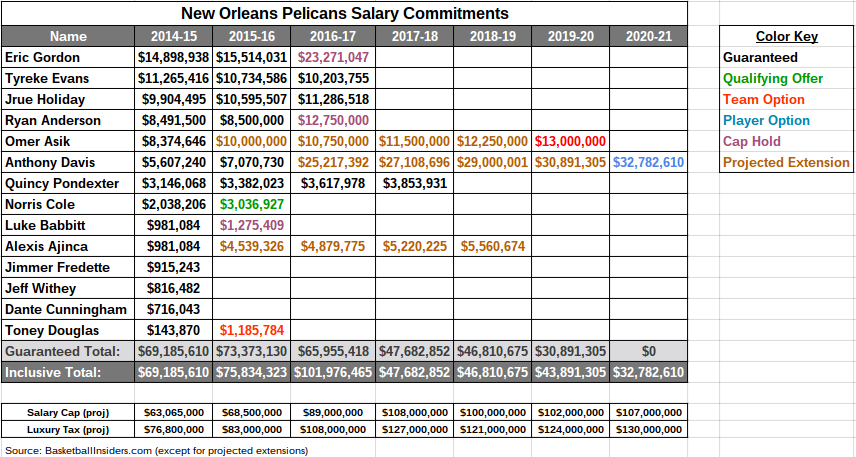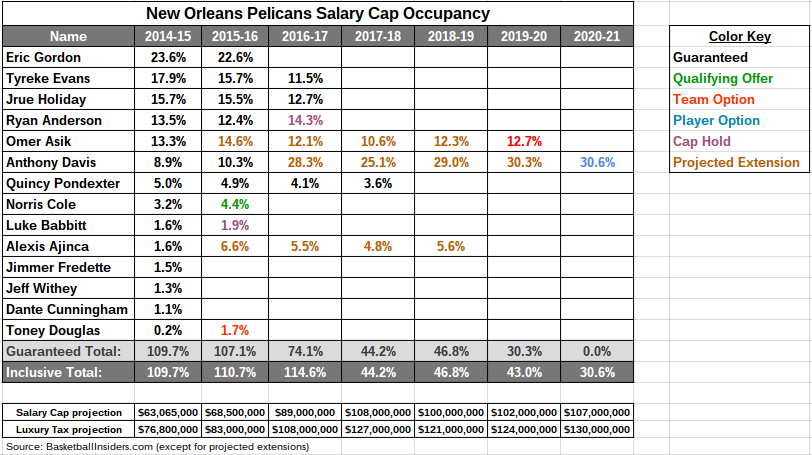This week, the Pelicans have verbally agreed to extend three of their four most important big men to long-term deals: Anthony Davis, Omer Asik, and Alexis Ajinca. From a financial perspective, each player’s average annual salary is in line with what most of us here at Bourbon Street Shots expected them to get: $29 million for Davis, $11 million for Asik, $5 million for Ajinca (I actually nailed Ajinca’s $4.5 million salary for year 1 of his contract with my salary cap post back in early May, though I did not expect the Pelicans to be the team giving it to him). That being said, some of us (myself included) are not thrilled with the length of Asik and Ajinca’s signed contracts, mainly due to salary cap and roster flexibility concerns.
My goal in this column is not to say Dell Demps made the right move in locking Asik and Ajinca in for the next 4 years; in my opinion, they’re both at least one guaranteed year too long, possibly two. What I aim to do here is to show you that these contracts are by no means worth panicking over. I know many of you have heard “the cap is going way up” so many times that you’re numb to it by now, so allow me to present my case visually instead of verbally.
Salary Commitments
This chart shows the salary commitments for the Pelicans after their verbal agreements on July 1st. The projected extensions are based off of reported totals and 7.5% annual raises, but there has not yet been confirmation on the exact annual salaries.
Salary Cap Occupancy
This table shows what percentage each player’s salary makes up of the entire salary cap for that year. It is important to note that the 2016-17 season and beyond uses the cap projections that the NBA sent out, but because the collective bargaining agreement contains a mutual opt-out clause after the 2016-17 season, those numbers will likely end up changing.
Takeaways
1) After this upcoming season, Omer Asik will never account for a higher percentage of the salary cap than any of the years of his prior 3-year contract. That’s not usually how this works! As successful players age, they typically account for more and more of the cap until they get into their 30s, when their salaries plummet. Asik is going to be 32 by the end of his last guaranteed year, which basically takes him up until you can reasonably expect to see a decline. Getting better value on a player in his late-20s than his mid-20s just doesn’t happen very often. Would it have been nicer to shorten the deal by a year? Sure, but there is absolutely no reason to panic.
2) Ajinca’s cap hit post-“cap spike” is similar to what Pondexter’s hit is pre-“cap spike”. Many people have been calling Pondexter’s contract a “steal” even before the salary cap jump. Well guess what? As a percentage of the cap, Ajinca will account for about the same percentage in the final three seasons of his deal that Pondexter does for last season or this season.
3) Anthony Davis will be one of the best bargains in the NBA for the duration of his contract. While it doesn’t excuse overspending, the Pelicans have a security blanket who goes by the name of Anthony Davis. Pretty soon (and probably already), his true worth will be at least 60% of the salary cap, if not more. The Pelicans have him locked in for 10% next year, and around 25-30% for the subsequent four seasons. That kind of value gives a team much more flexibility with roster construction (just ask the Spurs or either LeBron James title team, whose stars have consistently taken less than market value for the good of the team).
BONUS: The Pelicans can still easily make space for a max contract in 2016. While it’s not in either of the tables above, the 7-9 year player max contract will start around $25 million. Provided the team doesn’t sign Cole and Cunningham (or whoever they use part or all of the MLE on) to outlandish extensions, all it would take is unloading a contract like Tyreke Evans – one whose $10 million salary in 2016-17 will be great value – to once again have the requisite space to bring in a max contract caliber player. If you’re worried about not being able to do that, you can put those concerns to rest.



5 responses to “Transitioning into the new NBA Salary Cap Environment”
Underrated aspect of the transition: in light of the new contacts going around, for the upcoming year, eg is only slightly overpaid instead of grossly!!
We need to add some more swag, and energy to the roster. Maybe an enforcer. I know we pride ourselves on having good laidback chill players, that’s cool and all but i think that holding us back from being a title contender. Many times last year we got too relaxed in games and lost big leads and lost to teams we should have beat. Our team may not have a big 3 but we the best player in the world and 5 substar and 2 sidekicks, when healthy our offensive is unstoppable, that alone makes us a playoff. But to run for a title we need players with a winning swagger ( resign Norris Cole), a hustler s who influence his teammates to do the same ( sign Corey Brewer or Kj McDaniel), someone who would do anything to win but not dirty ( sign Quincy Acy), and a Vet someone who been there knows the system willing to teach ( maybe sign Barbosa). I really believe these are our missing peices, like Gentry said ” why we can’t be the this year Warriors”.
But first thing first please god let us stay healthy.
Just my thought.
[…] Transitioning into the new NBA Salary Cap Environment – From a financial perspective, each player’s average annual salary is in … s hit is pre-“cap spike”. Many people have been calling Pondexter’s contract a “steal” even before the salary cap jump. Well guess … […]
You’re right, we’ve heard “the cap is going up” until we’re numb. My question: Why is the cap less in 19, 20 & 21 than it is in 18? Modest raises those years could further emphasize the points you are making, which is an added bonus.
Side note: Joel Myers has a show on Sirius XM radio and I heard him yesterday suggest the KD-to-NO (next summer) scenario on national radio! I don’t know how we play them together but it got me salivating again at the possibilities! 😀 His suggestion only included the fact that EG and Rino are coming off the books and at that point didn’t see the need for unloading anyone (Tyreke?).
[…] Transitioning into the new NBA Salary Cap Environment – … what percentage each player’s salary makes up of the entire salary cap for that year. It is important to note that the 2016-17 season and beyond uses the cap projections that the NBA sent out, but because the … […]